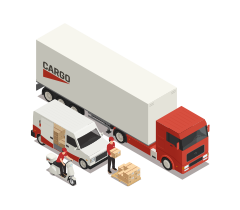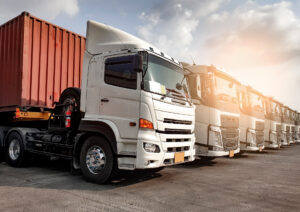

Road Freight refers to the movement of cargo by road using various types of vehicles. It is a versatile and widely used method of transportation, offering a range of services from local deliveries to long-distance hauling. Here’s a comprehensive overview:
- Types of Road Freight Services:
- Full Truckload (FTL): Involves using an entire truck to transport goods for one customer. This is ideal for large shipments or when the cargo fills the truck’s capacity.
- Less Than Truckload (LTL): Involves sharing truck space with goods from multiple customers. This is suitable for smaller shipments that do not require a full truck.
- Dedicated Transport: Provides a dedicated vehicle for the exclusive use of a single customer, often for high-value or time-sensitive cargo.
- Express Delivery: Offers expedited shipping with fast delivery times, often including guaranteed delivery windows.

- Advantages of Road Freight:
- Flexibility: Road freight provides flexible routing options, allowing direct deliveries to specific locations without the need for transshipment.
- Accessibility: Can reach locations that are not accessible by other modes of transport, including rural areas and locations with limited access to ports or rail networks.
- Cost-Effectiveness: Generally cost-effective for shorter distances and smaller shipments compared to air freight.
- Key Components:
- Vehicles: Various types of road freight vehicles are used, including:
- Trucks: Heavy-duty vehicles used for long-distance and bulk cargo transportation.
- Vans: Smaller vehicles suitable for local deliveries and smaller loads.
- Refrigerated Trucks: Equipped with cooling systems to transport perishable goods.
- Drivers: Professional drivers responsible for operating the vehicles, ensuring safe and timely delivery.
- Logistics Providers: Companies that manage road freight operations, including route planning, scheduling, and customer service.
- Vehicles: Various types of road freight vehicles are used, including:
- Logistics and Operations:
- Route Planning: Involves optimizing routes to reduce transit times and costs, considering factors such as traffic conditions, road restrictions, and delivery schedules.
- Load Optimization: Ensures efficient use of vehicle space to maximize cargo capacity and reduce shipping costs.
- Tracking and Monitoring: Uses GPS and tracking systems to monitor the location and status of shipments in real-time, providing updates to customers.
- Cargo Handling:
- Loading and Unloading: Involves the safe handling of goods during loading and unloading, including the use of equipment like forklifts and pallet jacks.
- Securing Cargo: Ensures that goods are securely fastened and protected during transit to prevent damage.
- Regulations and Compliance:
- Transportation Regulations: Compliance with national and international regulations governing road freight, including vehicle standards, driver hours, and safety requirements.
- Customs Requirements: For international road freight, adherence to customs regulations and documentation is required to facilitate cross-border shipments.
- Cost Considerations:
- Pricing: Road freight costs are influenced by factors such as distance, load size, vehicle type, and fuel prices. Pricing models may include flat rates, per-mile charges, or weight-based rates.
- Fuel Costs: Fuel is a significant cost factor in road freight, and fluctuations in fuel prices can impact overall shipping costs.
- Environmental Impact:
- Emissions: Road freight contributes to greenhouse gas emissions and air pollution. Efforts to reduce environmental impact include adopting fuel-efficient vehicles and exploring alternative fuels.
- Sustainability: Initiatives to improve sustainability include optimizing routes, reducing idle times, and implementing green technologies.
- Future Trends:
- Technological Innovations: Advancements in technology, such as telematics, autonomous vehicles, and electric trucks, are shaping the future of road freight.
- Enhanced Efficiency: Continued focus on improving operational efficiency through better route planning, load optimization, and integration with other transport modes.
- Customer Experience:
- Communication: Provide timely updates and transparent communication regarding delivery status, potential delays, and any issues that arise.
- Service Quality: Ensure high standards of service, including reliable delivery times, professional handling of cargo, and responsive customer support.

